Electric circuits miscellaneous
- The sinusoidal steady-state voltage gain of the network shown in the given figure will have magnitude equal to 0.707 at an angular frequency of
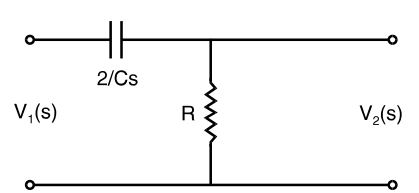
-
View Hint View Answer Discuss in Forum
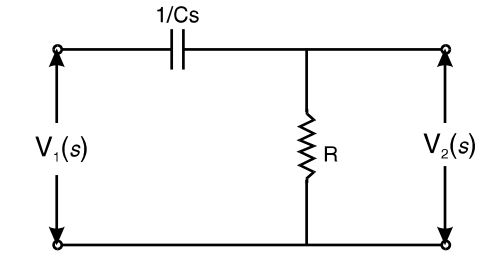

M(jω) = V2(jω) V1(jω) 
Correct Option: C


M(jω) = V2(jω) V1(jω) 
- For the circuit shown in the figure, the current I is
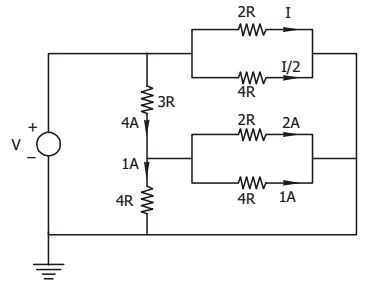
-
View Hint View Answer Discuss in Forum
Redrawing the circuit, we have

From the circuit, V = 2RI ....(i)
and, V = (3R)4 + (4R). 1 = 16 R ....(ii)
From equations (i) and (ii), we get I = 8ACorrect Option: D
Redrawing the circuit, we have

From the circuit, V = 2RI ....(i)
and, V = (3R)4 + (4R). 1 = 16 R ....(ii)
From equations (i) and (ii), we get I = 8A
- If a resistance R of 1 Ω is connected across the terminals AB as shown in the given figure, then the current flowing through R will be
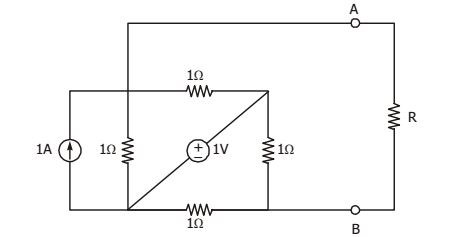
-
View Hint View Answer Discuss in Forum
Shorting the voltage source and opening current source, we have ZTH = 1 Ω looking left into terminal AB.
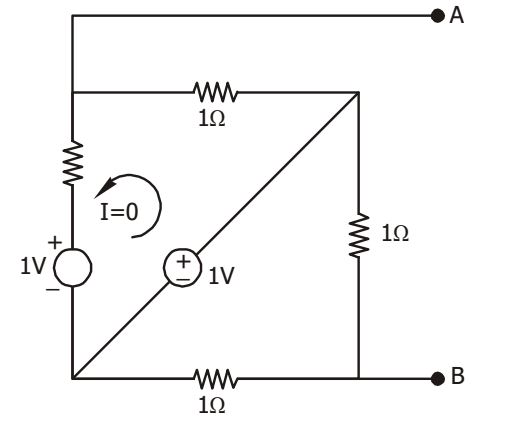
Now, for VTH, from the circuit, we have
VAB = VTH = 1 volt
Then, current through R= VAB = 1 = 0.54 R + ZTH 2
Correct Option: B
Shorting the voltage source and opening current source, we have ZTH = 1 Ω looking left into terminal AB.

Now, for VTH, from the circuit, we have
VAB = VTH = 1 volt
Then, current through R= VAB = 1 = 0.54 R + ZTH 2
- In the given circuit, V1 = 40 V when R is 10 Ω . When R is zero, the value of V2 will be

-
View Hint View Answer Discuss in Forum
Applying KCL at node (1), we have
V1 - 60 + V1 + V1 - V2 = 0 10 20 R ⇒ 
V1 - 60 + V1 + V1 
= V2 10 20 R R ⇒ V2 = 
V1 - 60 + V1 
R + V2 10 20
R = 0 gives, V2 = V1Also , V1 - 60 + V1 = 0 10 20
⇒ V1 = 40 volts
∴ V2 = 0 VCorrect Option: A
Applying KCL at node (1), we have
V1 - 60 + V1 + V1 - V2 = 0 10 20 R ⇒ 
V1 - 60 + V1 + V1 
= V2 10 20 R R ⇒ V2 = 
V1 - 60 + V1 
R + V2 10 20
R = 0 gives, V2 = V1Also , V1 - 60 + V1 = 0 10 20
⇒ V1 = 40 volts
∴ V2 = 0 V
- In the circuit shown in the given figure, if I1 = 1.5 A, then I2 will be
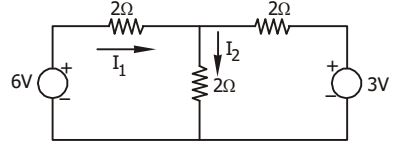
-
View Hint View Answer Discuss in Forum
From the circuit, we have
6 = 2I1 + 2I2
⇒ I2 = 1.5ACorrect Option: C
From the circuit, we have
6 = 2I1 + 2I2
⇒ I2 = 1.5A

